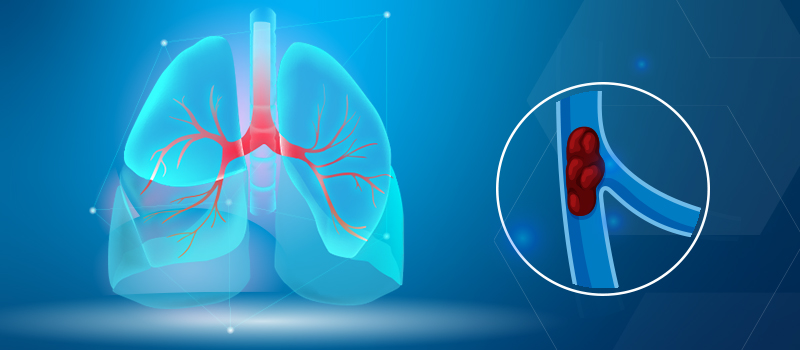Pulmonary Embolism is when the pulmonary arteries suddenly block, and blood flow to the lungs experiences difficulties. The condition usually results from a blood clot in your leg’s deeper vein breaking off and traveling to the lungs. So the term embolus refers to this clot, and when it causes vessel blockage, it is called Embolism. In the case of pulmonary blockage, it can be life-threatening, but there are preventative measures ( to be discussed later)

Causes
Beyond the clot breaking off from your leg’s deepest vein, other reasons include,
- Air bubble
- Tumor
- Clots from upper body deeper veins
- Fats moving from a critically broken bone
- Genealogy history of clot disorder
- Heart disease
- Prolonged usage of birth control pills
- Long flights or rides
- Prolonged bed rest
- Surgery, burns, or fractures
Symptoms
Symptoms of pulmonary Embolism may depend on clot size and your general health. But you may experience the following.
- Coughing blood embedded in mucus
- Dizziness
- Cardiac palpitation
- Swollen legs or leg pains
- Sharp and momentarily chest pain
- Breathing difficulties

Risks
A pulmonary embolism can be life-threatening without treatment. It can cause several complications, including:
- Cardiac arrest
- Cardiac arrhythmia,
- Pleural effusion,
- Pulmonary hypertension
Diagnosis
Your doctor will have to examine you physically and ask about the signs you have experienced. Then they can order tests that comprise
- Blood test to check for clot presence
- Chest x-rays to see heart and lung condition
- Doppler ultrasound which finds clots within your legs
- Lab tests to determine the oxygen level in arterial blood.
- Echocardiogram for checking your heart and vessel structure
- CT angiography, which creates 3D images of the heart and lungs
- Pulmonary angiogram for visualizing blood movement throughout the artery
- Ventilation-perfusion by Injecting tracers in your blood to track the blood flow
Treatment
At Washington Vascular Specialists, our doctors are proficient in term-based attendance to severe or lingering pulmonary embolisms. Our response team is one of the most advanced in the nation, and we offer innovative treatments and diagnoses.

Pulmonary Embolectomy
Besides giving prescriptions for drugs that dissolve clots, we do clot removal by using a catheter to find and break the clot in your artery. This targeted treatment can also pull out the clot.
Filter Replacement
The other treatment is filter replacement in your inferior Vena cava. Here our professionals situate a filter in the main vein that brings blood from your legs to the heart. The filter will prevent the clot from reaching the heart or moving to the lungs.
Catheter-Directed Thrombolysis
This technique involves delivering clot-dissolving medications directly to the site of the clot through a catheter. The medication help break down the clot and restore blood flow.
Mechanical Thrombectomy
In this procedure, specialized devices are used to physically break up or extract the clot. Examples include suction devices, mechanical rotating catheters, or devices that fragment the clot for easier removal.
Angioplasty
Lastly, there is the Balloon pulmonary angioplasty for patients with multiple emboli. In this treatment, a catheter is interested in your groin and guided to the arteries. Once in place, the balloon is inflated, forcing the blocked artery to pen and restore blood flow.
As a dedicated team, we strive to provide the highest quality of care to our patients, ensuring their well-being and optimal outcomes. Contact 301-891-2500 to book an appointment.



